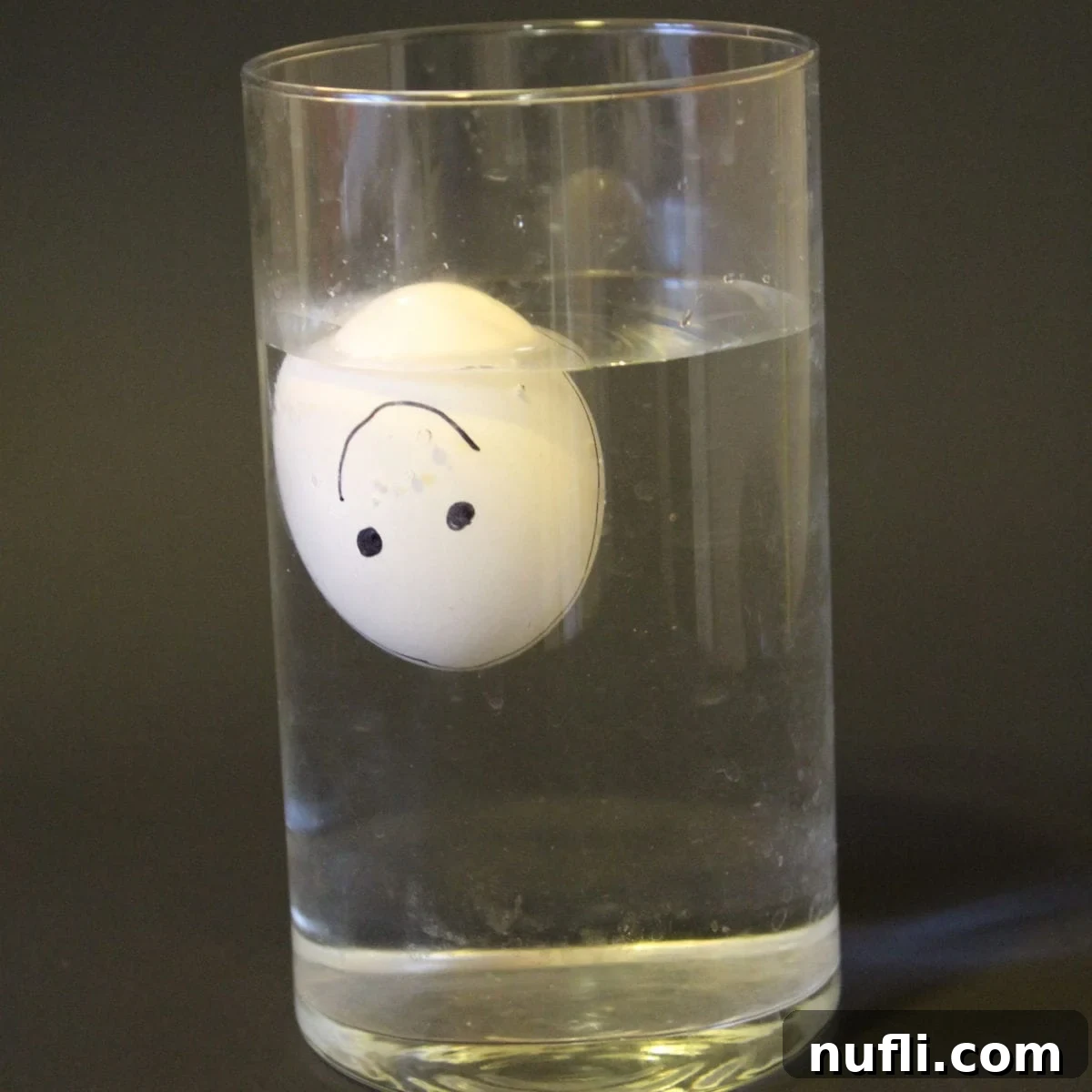How to Tell if Eggs are Fresh: The Ultimate Guide to the Egg Float Test and Food Safety
Have you ever found yourself staring at a carton of eggs, past its “sell-by” date, wondering if they’re still safe to eat? The fear of accidentally serving spoiled food or wasting perfectly good ingredients is a common concern for many home cooks. Eggs are a kitchen staple, versatile and nutritious, but their freshness is paramount for both taste and safety. This uncertainty often leads to prematurely discarding dozens of eggs, contributing to unnecessary food waste and hitting our wallets.
The good news is that you don’t have to rely solely on the date printed on the carton. There are simple, reliable methods to determine an egg’s freshness, helping you make informed decisions and save money. In this comprehensive guide, we’ll dive deep into the most popular and scientifically backed method – the egg float test – and explore other practical ways to ensure your eggs are safe and delicious. By understanding these techniques, you’ll gain confidence in your kitchen, reduce waste, and never second-guess an egg’s quality again.
Understanding Egg Dates: “Sell-By” vs. Actual Freshness
Before we delve into testing methods, it’s crucial to clarify the common confusion surrounding egg carton dates. The date printed on your egg carton is most often a “sell-by” date, not a strict expiration date. This date primarily guides retailers on how long to display eggs for sale to ensure optimal quality for consumers. It doesn’t necessarily mean the eggs are unsafe or spoiled the day after this date passes.
In fact, properly refrigerated eggs can remain fresh and safe to consume for up to three to five weeks beyond the “sell-by” date. The key here is “properly refrigerated.” This significant window means that many people are throwing out perfectly good eggs simply because they misunderstand the label. Knowing how to assess an egg’s true freshness can lead to substantial savings and a considerable reduction in food waste.
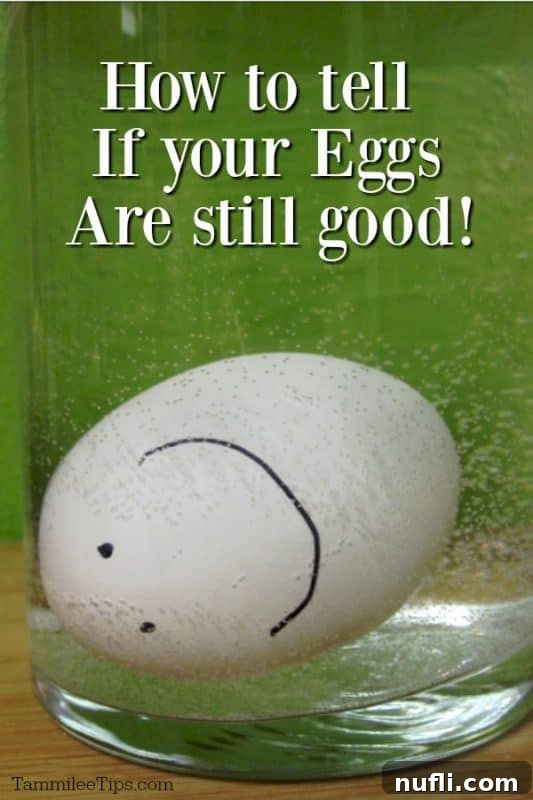
The Science Behind the Egg Float Test: Why It Works
The egg float test is a remarkably simple yet effective method, and its reliability is rooted in basic egg biology. An eggshell is porous, meaning it has tiny holes that allow air and moisture to pass through. When an egg is laid, it contains a small air cell, usually at the larger end.
As an egg ages, two primary things happen:
- Moisture Evaporation: Water content slowly evaporates through the porous shell.
- Air Cell Expansion: As moisture leaves, air enters to fill the vacuum, causing the air cell inside the egg to grow larger.
A very fresh egg has a tiny air cell and is relatively dense, causing it to sink and lie flat. An older egg, having lost more moisture and gained more air, will be more buoyant and begin to stand upright or even float. This physical change is what the float test precisely measures, giving you a clear indicator of its age and, consequently, its freshness.
Performing the Egg Float Test: A Step-by-Step Guide
This classic test is incredibly easy and requires nothing more than a bowl of water and your eggs. Here’s how to do it correctly:
Step 1: Gather Your Supplies
You’ll need a bowl or pan large enough to completely submerge an egg. Fill it with enough cold water to cover the egg by at least an inch or two.
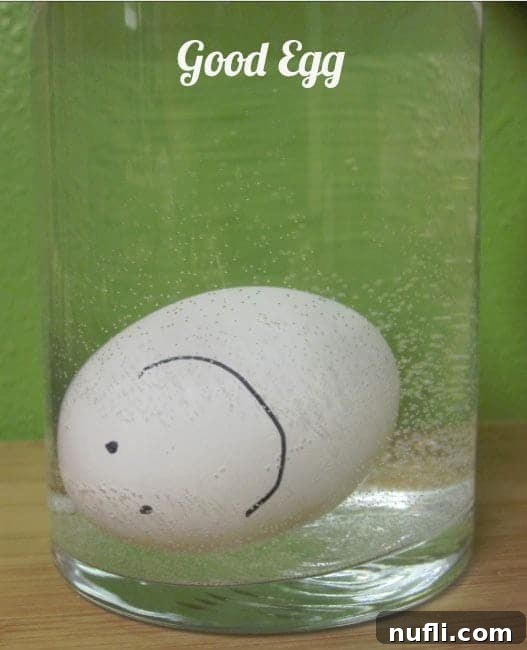
Step 2: Observe the Egg’s Behavior
Gently place the egg into the water and watch how it behaves. The way it positions itself will tell you everything you need to know about its freshness.
Scenario 1: Very Fresh Egg (Lies Flat)
If the egg lies flat on its side at the bottom of the bowl, it is incredibly fresh. Its air cell is very small, making it dense enough to stay completely submerged and horizontal. These eggs are perfect for any recipe, especially those where freshness impacts texture or flavor, like poaching or frying.
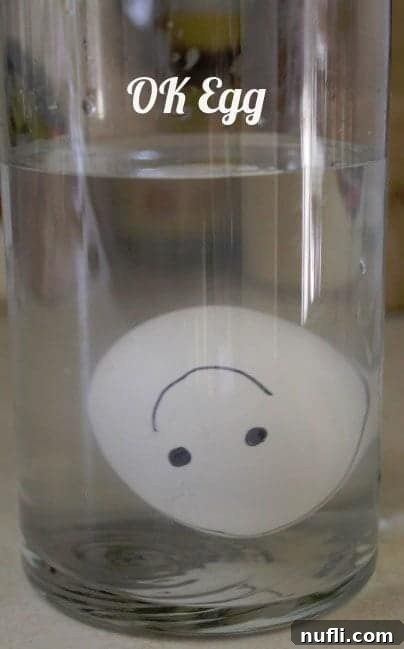
Scenario 2: Still Good, Use Soon (Stands Upright)
If the egg stands upright on the bottom, with its pointy end down and the rounded end (where the air cell is) pointing upwards, it means the egg is older but still perfectly safe and good to eat. The air cell has expanded somewhat, giving it just enough buoyancy to stand. These eggs are ideal for hard-boiling, as the slightly larger air pocket makes them easier to peel.
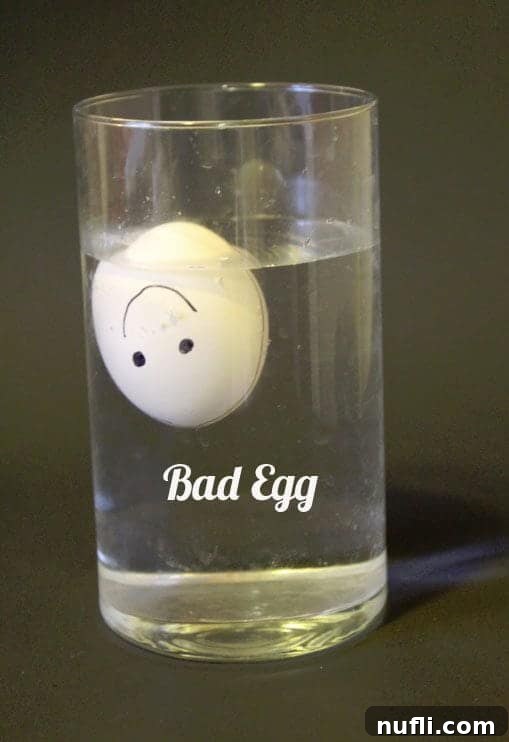
Scenario 3: Discard (Floats)
If the egg floats completely to the surface of the water, it is old and should be discarded. A floating egg indicates that a significant amount of moisture has evaporated, and a large amount of air has entered the egg, making it too buoyant. While a floating egg doesn’t always guarantee spoilage, it’s a strong indicator that its quality has significantly deteriorated, and it’s best to err on the side of caution for food safety.

Beyond the Float Test: Other Ways to Check Egg Freshness
While the float test is excellent, it’s not the only method to assess egg freshness. Combining multiple techniques can give you even greater confidence:
The Smell Test: The Ultimate Indicator of Spoilage
This is arguably the most definitive test for a truly spoiled egg. If an egg has gone bad, it will emit an unmistakable, pungent, sulfuric odor, often described as rotten eggs or sulfur. This smell is present whether the egg is raw or cooked. If you crack an egg and detect an unpleasant smell, discard it immediately, regardless of what the float test indicated.
Visual Inspection (Shell and Contents)
- Shell: Before cracking, check the shell for any slime or powdery residue. Slime can indicate bacteria, while a powdery appearance might suggest mold. Both are signs to discard.
- Cracked Egg: Once cracked, observe the yolk and albumen (egg white).
- Fresh Egg: A fresh egg will have a firm, round, high-standing yolk. The egg white will be thick and cloudy, holding tightly around the yolk, with a smaller amount of thinner white spreading further out.
- Older Egg: As an egg ages, the yolk flattens, and the egg white becomes thinner and more watery, spreading out rapidly. While this doesn’t mean it’s spoiled, it indicates older age and might affect the texture in some recipes (e.g., meringue).
The Shake Test (Less Reliable but Quick)
Hold an egg to your ear and shake it gently. If you hear a sloshing sound, it means the yolk and white have thinned and are moving freely inside the shell due to a larger air cell. While not a precise indicator of spoilage, it confirms the egg is older. A fresh egg should have no discernible sound when shaken.
Optimal Egg Storage for Maximum Freshness
Extending the life of your eggs begins with proper storage. Follow these tips to keep your eggs fresher for longer:
- Refrigerate Promptly: Always store eggs in the refrigerator as soon as you bring them home. Consistent cold temperatures inhibit bacterial growth.
- Keep Them in the Original Carton: The carton protects eggs from absorbing odors from other foods in the fridge through their porous shells. It also helps prevent moisture loss and shields them from temperature fluctuations.
- Avoid the Refrigerator Door: While convenient, the refrigerator door is the warmest part of the fridge and experiences the most temperature fluctuations. Store eggs on an inner shelf, towards the back, where the temperature is more consistent and colder.
- Don’t Wash Eggs: Commercial eggs in the U.S. and some other countries are washed and then coated with a thin, protective mineral oil layer to seal pores. Washing them at home can remove this protective layer, making them more susceptible to bacterial contamination.
How Long Do Eggs Really Last?
With proper refrigeration, raw eggs in their shell can typically last for 3 to 5 weeks past the “sell-by” date. Hard-boiled eggs, however, have a much shorter shelf life and should be consumed within one week. Always store hard-boiled eggs in their shells in the refrigerator to maintain freshness.
When in Doubt, Throw It Out
While these tests are highly reliable, remember that food safety is paramount. If you’ve performed the float test, checked for smells, and visually inspected the egg, but still have any lingering doubts or concerns about its freshness or safety, it is always best to err on the side of caution and discard the egg. Your health and peace of mind are worth more than a single egg.
Saving Money and Reducing Waste: The Benefits of Knowing
Learning how to accurately assess egg freshness empowers you to make smarter choices in the kitchen. By confidently using eggs that are still good, even past their “sell-by” date, you will:
- Save Money: Avoid discarding dozens of perfectly good eggs, which adds up over time.
- Reduce Food Waste: Contribute to a more sustainable household by minimizing unnecessary food disposal.
- Gain Confidence: Cook with peace of mind, knowing your ingredients are fresh and safe.
A Fun and Educational Project for All Ages
The egg float test is also a wonderful and engaging activity for kids. It’s a simple science experiment that can teach them early lessons about food safety, observation, and critical thinking. Plus, it’s a great opportunity to get creative – maybe even drawing a smiley face on a “good” egg before cracking it! This hands-on experience can make learning about kitchen hygiene both memorable and fun.
Delicious Egg Recipes to Enjoy Your Fresh Eggs
Now that you’re an expert in egg freshness, put your skills to good use with these fantastic egg-centric recipes:
- Classic Scotch Egg Recipe
- Zesty Spicy Deviled Eggs
- Easy Crockpot Hard-Boiled Eggs
- Hearty Crockpot Bacon Egg Breakfast Casserole
- Mediterranean Crockpot Greek Frittata
Looking for more culinary inspiration? Explore our wide array of recipes:
- Irresistible Copycat Recipes
- Decadent Dessert Recipes
- Convenient Crockpot Recipes
Stay connected for all our latest recipe posts and kitchen tips! Follow Tammilee Tips on Facebook, Instagram, and Pinterest.
First published: January 8, 2013. Last updated: March 16, 2022.
